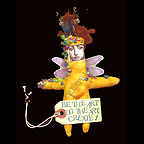Today’s paper dolls evolved from the development of paper, ceremonial and performance figures, and dressmakers’ fashion dolls.
General history
Paper was invented in China around 105 C.E. by Ts’ai-Lin, a courtier from Lei-yang. Although the word ‘paper’ is derived from ‘papyrus’, this early paper was not a papyrus product.
With paper’s development in nearby China, it should be no surprise that the earliest paper dolls were reported in Japan, in 900 C.E. (or earlier) when a purification ceremony involved placing in a boat a paper figure and a folded kimono-like object.
China was likewise responsible for the Spanish pinata–according to legend–when 13th-century explorer Marco Polo brought the tradition home from his travels in Asia. And, it is possible that the western movement of paper dolls began in China, where puppets were used in shadow shows. These large puppets were often flat and mounted on sticks, to create dramatic shadows on a screen.
Some paper doll historians include the shows created for the upper class in France, where life-sized jumping-jack figures, like marionettes were used to satirize nobility. And, there were other cultures practicing a variety of paper arts–including the German scherenschnitte,–that may have influenced the development of paper dolls.
However, our modern paper dolls trace a more direct history to traditional dolls, not puppets or even paper arts.
Dolls in general date from earliest recorded history. Manufactured dolls trace their European popularity to wooden dolls made in Germany in the 17th century. To meet demand by the early 18th century, German dollmakers were employed throughout Europe.
Modern paper dolls
Paper dolls appeared in Western society in the late 18th century, when French dressmakers’ life-sized dolls were replaced with the “English fashion doll.” These eight-inch tall figures were printed on cardboard (invented by the Chinese about 200 years earlier), and jointed with threads. They came with underclothing as well as several changes of dresses and coiffures. At about three shillings (about $15 in today’s American dollars) for a complete doll and wardrobe–plus an envelope to store her in–dressmakers could afford to own several sets, and distribute these dolls among their favorite customers.
 In 1810, the London firm of S. & J. Fuller & Company printed the first commercially popular paper doll, Little Fanny, with a 15-page book that included seven figures and five hats. Fanny’s head & neck were separate, and fitted into various outfits as the moral tale, The History of Little Fanny: Exemplified in a Series of Figures,was told. (Fuller also published the earliest “peep show” books, which were hinged, tunnel-style books.)
In 1810, the London firm of S. & J. Fuller & Company printed the first commercially popular paper doll, Little Fanny, with a 15-page book that included seven figures and five hats. Fanny’s head & neck were separate, and fitted into various outfits as the moral tale, The History of Little Fanny: Exemplified in a Series of Figures,was told. (Fuller also published the earliest “peep show” books, which were hinged, tunnel-style books.)
At five to eight shillings for each book, their primary audience included wealthy families. (Today, that’s the equivalent of 9 to 15 pounds, or US$13 – $22.)
The success of Little Fanny was followed two years later in America, when J. Belcher printed a paper doll with a similar moral tale, The History and Adventures of Little Henry.Within ten years, boxed sets of paper dolls were popular playthings for children in Europe and America.
These dolls were often lithographed or hand-tinted, although some were left black-and-white for children to color.
Beginning in the 1830s, celebrity paper dolls featured entertainers such as ballerinas and characters from the P. T. Barnum Circus, as well as British royalty. And, in 1838 when Charles Fenerty made the first paper–newsprint–from wood pulp, the price of paper dropped dramatically. Paper dolls became affordable for more families.
McLoughlin Brothers in the United States–later purchased by Milton Bradley–quickly became one of the largest manufacturers of paper dolls, printing them from engraved wooden blocks. Dottie Dimplewas one of their most successful paper dolls, and McLoughlin was a leader in this field throughout the 19th century.
Several other American companies, including Crosby, Nichols & Company (Boston), Frederick Stokes, and–later–Selchow and Righter, contributed many different styles of paper dolls to meet popular demand.
During the Victorian era, Godey’s Lady’s Book, was the first magazine to publish a paper doll in their November 1859 issue.
This article continues in History of Paper Dolls – Part Two.


